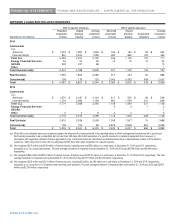GE 2014 Annual Report Download - page 225
Download and view the complete annual report
Please find page 225 of the 2014 GE annual report below. You can navigate through the pages in the report by either clicking on the pages listed below, or by using the keyword search tool below to find specific information within the annual report.
GE 2014 FORM 10-K 205
FINANCIAL STATEMENTS FINANCIAL INSTRUMENTS
NET INVESTMENT HEDGES IN FOREIGN OPERATIONS
We use currency exchange derivatives to protect our net investments in global operations conducted in non-U.S. dollar
currencies. For derivatives that are designated as hedges of net investment in a foreign operation, we assess effectiveness
based on changes in spot currency exchange rates. Changes in spot rates on the derivative are recorded as a component of
AOCI until such time as the foreign entity is substantially liquidated or sold, or upon the loss of a controlling interest in a foreign
entity. The change in fair value of the forward points, which reflects the interest rate differential between the two countries on
the derivative, is excluded from the effectiveness assessment.
GAINS
(
LOSSES
)
RECOGNIZED THROUGH CTA
Gain (loss) recognized in CTA Gain (loss) reclassified from CTA
(In millions) 2014 2013 2014 2013
Currency exchange contracts(a) $ 5,741 $ 2,322 $ 88 $ (1,525)
(a) Gain (loss) is recorded in GECC revenues from services when reclassified out of AOCI.
The amounts related to the change in the fair value of the forward points that are excluded from the measure of effectiveness
were $(549) million and $(678) million for the years ended December 31, 2014 and 2013, respectively, and were recorded in
interest and other financial charges.
FREE-STANDING DERIVATIVES
Changes in the fair value of derivatives that are not designated as hedges are recorded in earnings each period. As discussed
above, these derivatives are typically entered into as economic hedges of changes in interest rates, currency exchange rates,
commodity prices and other risks. Gains or losses related to the derivative are typically recorded in GECC revenues from
services or other income, based on our accounting policy. In general, the earnings effects of the item that represent the
economic risk exposure are recorded in the same caption as the derivative. Gains (losses) for the year ended December 31,
2014 on derivatives not designated as hedges were $(2,045) million composed of amounts related to interest rate contracts of
$(58) million, currency exchange contracts of $(2,034) million, and other derivatives of $47 million. These losses were more
than offset by the earnings effects from the underlying items that were economically hedged. Gains (losses) for the year ended
December 31, 2013 on derivatives not designated as hedges were $(449) million composed of amounts related to interest rate
contracts of $(111) million, currency exchange contracts of $(595) million, and other derivatives of $257 million. These losses
were more than offset by the earnings effects from the underlying items that were economically hedged.
COUNTERPARTY CREDIT RISK
Fair values of our derivatives can change significantly from period to period based on, among other factors, market
movements and changes in our positions. We manage counterparty credit risk (the risk that counterparties will default and not
make payments to us according to the terms of our agreements) on an individual counterparty basis. Where we have agreed
to netting of derivative exposures with a counterparty, we net our exposures with that counterparty and apply the value of
collateral posted to us to determine the exposure. We actively monitor these net exposures against defined limits and take
appropriate actions in response, including requiring additional collateral.
As discussed above, we have provisions in certain of our master agreements that require counterparties to post collateral
(typically, cash or U.S. Treasury securities) when our receivable due from the counterparty, measured at current market value,
exceeds a specified limit. The fair value of such collateral was $7,070 million at December 31, 2014, of which $3,709 million
was cash and $3,361 million was in the form of securities held by a custodian for our benefit. Under certain of these same
agreements, we post collateral to our counterparties for our derivative obligations, the fair value of which was $502 million at
December 31, 2014. At December 31, 2014, our exposure to counterparties (including accrued interest), net of collateral we
hold, was $487 million. This excludes exposure related to embedded derivatives.
























